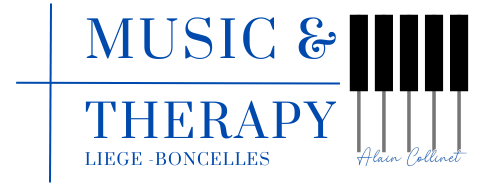Understanding the Slash: The Hypnosedative Technique
Understanding the Slash
The Slash Hypnosedative Technique – © Alain Collinet 1995.
The Slash Technique
The Slash Technique is based on the simultaneous adjustment of the tempo and energy of a musical piece, represented by various parameters such as the number of notes played, volume, and dynamic intensity.
This process — combining these two elements — activates the parasympathetic nervous system, promoting a relaxation response within the body.
In practice, the slowing of musical rhythms leads to a reduction in both respiratory and heart rates, a phenomenon well documented in scientific research.
For example, Bernardi, Porta & Sleight (2006) demonstrated that slow music synchronizes physiological rhythms, fostering deep relaxation.
This mechanism also influences cortisol and ACTH levels — two hormones closely linked to stress — by reducing their concentration in the body, as explored by Koelsch et al. (2009).
The emotional effects generated by music also play a crucial role.
By acting on neurotransmitters such as dopamine and serotonin, music helps improve mood and reduce anxiety.
This dynamic is supported by Chanda and Levitin (2013), who showed that music modulates dopaminergic and autonomic systems, producing measurable effects on stress and well-being.
This mechanism, combining physiological and psychological responses, aligns with research on how musical rhythms impact human physiology.
For instance, Trappe (2010) highlighted that slow tempos promote a calm state by modulating blood pressure and heart rhythms.
These observations also resonate with the findings of Blood and Zatorre (2001), who explored the effects of emotional music on the brain’s reward and relaxation circuits.
Overall, the Slash Technique fosters both physical and emotional slowing, acting simultaneously on bodily rhythms and mood.
This process illustrates the profound interaction between musical tempo, parasympathetic activation, and the release of neurotransmitters involved in stress regulation.

A therapeutic innovation built on years of research and clinical practice.
The “Slash” Technique
The “Slash” Technique is not simply a method of musical relaxation — it represents a unique therapeutic approach, combining music, hypnosis, and music therapy.
Developed in 1995 by myself, it was scientifically validated in 2021 through a study published in the journal PLOS ONE.
Unlike traditional methods of musical relaxation, the Slash Technique acts in a precise and targeted way, optimally modulating both physiological and psychological rhythms through a carefully designed musical structure.
An Innovative Approach: Combining Hypnosis and Music
This method draws its inspiration from medical hypnosis, particularly from the work of Professor Marie-Elisabeth Faymonville.
What distinguishes the Slash Technique is its direct integration of hypnotic metaphors and intentions within the musical composition itself, producing therapeutic effects that go far beyond simple relaxation.
By synchronizing the music with the body’s natural rhythms, it induces deep sedative states while optimizing the therapeutic impact.
A Flexible and Modular Method: From 1 to 3 Phases
The Slash Technique features a modular structure, allowing adaptation to each patient’s specific needs.
It is composed of three phases:
Initial Phase: Gradual reduction of tempo and musical energy to promote deep sedation or facilitate sleep.
Middle Plateau Phase: Stabilization at a low tempo, ideal for prolonged sedation and optimal relaxation.
Recovery Phase: Progressive increase in tempo and musical energy for a gentle return to wakefulness.
Each phase is carefully calibrated to induce specific physiological and psychological effects, aligned with the therapeutic goals of the patient.
A Scientifically Validated Protocol and Clinical Experience
The Slash Technique has been clinically validated at the University Hospital of Liège (CHU Liège), where it is currently used in two hospital departments to address issues such as pain management, stress reduction, and sleep disorders.
This scientific and clinical validation demonstrates the method’s efficacy and safety, positioning it as an innovative and reliable solution for a wide range of conditions.
Why Choose the “Slash” Technique?
Proven effectiveness: Scientific studies and clinical applications confirm measurable effects on the reduction of stress, anxiety, and pain.
A unique method: No other musical technique integrates medical hypnosis and musical metaphors at such a level.
Flexible and adaptable: Its structure can be tailored to specific therapeutic needs.
A perfect complement to clinical practice: Successfully integrated into two departments at CHU Liège, it offers a scientifically validated alternative to traditional relaxation and stress management methods.
Scientific Validation: Research study published in PLOS ONE
Slash Compositions
Slash Compositions are not merely musical works; they are also the subject of scientific research.
In collaboration with the University of Liège, the Interdisciplinary Pain Center, and the GIGA Conscious Care Lab, a study published in PLOS ONE explores the impact of music therapy through a comparative analysis.
Read or download the full study or its summary on music therapy.
Hypnosedative Technique / Slash Technique – A therapeutic approach based on musical hypnosis, © Alain Collinet 1995.
he music therapist is a healthcare professional!
The therapeutic forms offered are perfectly aligned with the spirit and ecology of our era.
©Alain Collinet 2024

